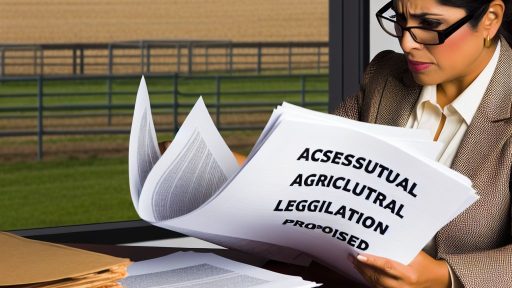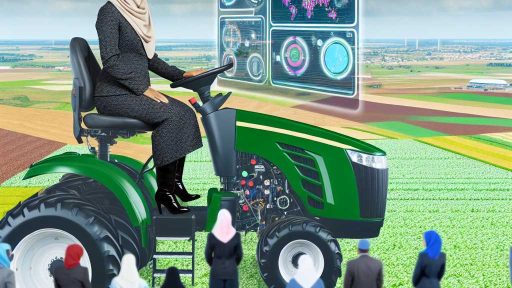Introduction to Emission Standards in Agriculture
Emission standards play a vital role in modern farming practices.
They establish limits on pollutants released into the environment.
Farmers must adhere to these regulations to minimize environmental impact.
Additionally, these standards promote sustainable agricultural practices.
In this section, we will explore various aspects of emission standards.
Importance of Emission Standards
Emission standards protect air quality for surrounding communities.
They also ensure that agricultural practices are sustainable.
Furthermore, these standards help to preserve biodiversity.
Compliance reduces the risk of legal issues for farmers.
Types of Emission Standards
Different types of emission standards apply to various pollutants.
For instance, nitrogen oxides and methane are common in agriculture.
Regulations may differ by region and farming type.
Explicit limits are established for each type of pollutant.
Methods of Compliance
Farmers can employ several methods to meet emission standards.
Utilizing precision agriculture technologies is one effective approach.
Transform Your Agribusiness
Unlock your farm's potential with expert advice tailored to your needs. Get actionable steps that drive real results.
Get StartedCrop rotation can also help improve soil health and reduce emissions.
Additionally, better manure management practices are beneficial.
The Role of Government and Organizations
Governments play a significant role in enforcing emission standards.
They issue guidelines and conduct inspections to ensure compliance.
Organizations also provide support and resources for farmers.
Education and training programs are essential for successful implementation.
Historical Context of Emission Regulations in Farming
Early Regulations and Public Awareness
Emission regulations in farming began gaining attention in the mid-20th century.
Public awareness of air and water pollution grew significantly during this time.
Concerns emerged about the impact of agricultural practices on the environment.
Environmental groups began advocating for stricter regulations and standards.
Development of National Policies
In the late 1960s, the U.S. government established the Environmental Protection Agency (EPA).
This agency aimed to regulate pollutants from all sectors, including agriculture.
Farmers faced pressure to adopt more sustainable practices.
Policies started to focus on reducing emissions from machinery and fertilizers.
International Trends and Agreements
Throughout the 1980s and 1990s, international agreements began to influence emission standards.
The Kyoto Protocol, for example, emphasized reducing greenhouse gas emissions.
Many countries adopted policies to comply with these international expectations.
This shift encouraged farmers worldwide to rethink their operational strategies.
Recent Developments and Future Directions
The 21st century has seen the rise of stricter regulations in many regions.
Climate change concerns prompted governments to implement more aggressive emission targets.
Technological advancements have introduced new methods for monitoring emissions.
Farmers now have access to tools that help them comply with these regulations.
Looking ahead, regulations will likely become even more stringent.
Farmers will need to adapt continually to remain compliant.
Showcase Your Farming Business
Publish your professional farming services profile on our blog for a one-time fee of $200 and reach a dedicated audience of farmers and agribusiness owners.
Publish Your ProfileTypes of Emissions Produced by Modern Farms
Greenhouse Gases
Modern farms produce various greenhouse gases, including carbon dioxide and methane.
These gases contribute significantly to global warming.
Farming practices like tillage can release stored carbon into the atmosphere.
Moreover, livestock generates methane during digestion, affecting air quality.
Agricultural Runoff
Agricultural runoff occurs when fertilizers and pesticides wash into water sources.
This runoff can lead to water pollution, harming aquatic ecosystems.
Eutrophication often results from excess nutrients in the water.
Consequently, algal blooms can suffocate fish and other aquatic life.
Ammonia Emissions
Ammonia emissions mainly originate from livestock waste and fertilizers.
These emissions can negatively impact air quality and human health.
When ammonia interacts with other pollutants, it forms fine particulate matter.
This particulate matter poses severe respiratory threats to nearby communities.
Pesticide Volatilization
Pesticides can volatilize and evaporate into the air after application.
This volatilization can lead to environmental contamination beyond targeted areas.
Such contamination may harm non-target species, including beneficial insects.
Furthermore, it can contribute to the formation of ground-level ozone.
Soil Erosion and Dust Emissions
Soil erosion is a significant issue on modern farms.
It can generate dust emissions that negatively affect air quality.
This dust may carry harmful particles long distances.
Effective soil management practices can help mitigate erosion issues.
Find Out More: Navigating Pesticide Use Laws
Overview of Current Emission Standards and Policies Globally
Global Emission Standards
Emission standards vary across countries and regions.
Each jurisdiction establishes its regulations based on environmental needs.
Countries like Germany promote stricter standards for agriculture.
Meanwhile, the United States emphasizes flexibility in compliance.
Many nations aim for the reduction of greenhouse gas emissions.
As a result, farmers must adapt their practices to meet these requirements.
Emission Standards in Europe
European Union regulations set ambitious targets for emissions reduction.
These policies often include limits on nitrogen oxide and ammonia emissions.
Farmers must implement measures to comply with these standards.
Moreover, penalties may apply for non-compliance.
Several funding programs support farmers in transitioning to greener practices.
Emission Standards in North America
In the United States, the Environmental Protection Agency oversees emissions regulations.
Specific regulations vary by state, creating a patchwork of standards.
Farmers are encouraged to adopt Best Management Practices (BMPs).
These aim to reduce emissions while maintaining productivity.
Furthermore, collaboration with local agencies fosters compliance and innovation.
Asia-Pacific Emission Policies
Countries like Japan and Australia focus on sustainable agriculture practices.
They encourage reducing chemical inputs and promoting renewable energy sources.
Regulations often reflect the growth of urban agriculture and its challenges.
Showcase Your Farming Business
Publish your professional farming services profile on our blog for a one-time fee of $200 and reach a dedicated audience of farmers and agribusiness owners.
Publish Your ProfileMoreover, government incentives support farmers’ adaptation efforts.
Emerging Trends and Practices
Many regions now emphasize carbon farming and soil health initiatives.
These practices enhance ecosystem services while reducing emissions.
Farmers utilize technology to monitor and minimize their emissions.
For instance, precision agriculture helps optimize inputs and outputs.
Consequently, farmers can achieve economic advantages alongside compliance.
Learn More: Key Aspects of Farm-To-Table Agricultural Legislation for Farmers
Impact of Emission Standards on Farm Operations and Productivity
Understanding Emission Standards
Emission standards are regulations aimed at reducing pollutants released into the environment from agricultural operations.
These standards vary by region and are influenced by national and international environmental policies.
Farmers must stay informed about the specific regulations applicable to their operations.
Effects on Operational Practices
Farm operations undergo significant alterations to comply with emission standards.
For instance, many farmers invest in cleaner technologies for machinery and equipment.
They may also adopt more efficient practices to reduce emissions.
This often involves updating irrigation systems or using precision agriculture techniques.
Benefits of Compliance
Complying with emission standards can enhance a farm’s reputation.
Consumers increasingly prefer products from environmentally responsible farms.
This can lead to higher market prices and increased customer loyalty.
Ultimately, sustainable practices can contribute to the long-term viability of farming operations.
Challenges Faced by Farmers
Adhering to strict emission standards can be costly for farmers.
Initial investments in new technology or retrofitting existing equipment may be substantial.
Furthermore, compliance requires ongoing monitoring and management of emissions.
Many farmers, especially small-scale operators, may struggle with these financial burdens.
Impact on Productivity
While compliance with emission standards may seem daunting, it can lead to increased efficiency.
For instance, improved machinery can result in faster operations and lower fuel costs.
Consequently, farmers might see a boost in overall productivity and crop yields.
Moreover, adopting sustainable practices often improves soil health over time.
Support and Resources
Farmers can find support through government programs aimed at helping with compliance.
Additionally, many agricultural organizations offer resources and training on best practices.
Networking with other farmers facing similar challenges can also provide valuable insights.
Ultimately, tapping into available resources can mitigate some of the burdens associated with emissions compliance.
Find Out More: Implementing Green Regulations on the Farm
Technological Innovations to Meet Emission Standards
Introducing Precision Agriculture
Precision agriculture leverages technology to enhance farming efficiency.
This method utilizes data analytics to optimize resource usage.
Farmers can monitor soil conditions and crop health in real time.
Consequently, they reduce unnecessary inputs, minimizing emissions.
Implementing Renewable Energy Sources
Many farms are adopting renewable energy solutions.
Solar panels provide a sustainable way to power agriculture operations.
Wind turbines also contribute to reducing reliance on fossil fuels.
These innovations decrease greenhouse gas emissions significantly.
Utilizing Advanced Fertilization Techniques
New fertilization technologies help minimize nitrogen runoff.
Showcase Your Farming Business
Publish your professional farming services profile on our blog for a one-time fee of $200 and reach a dedicated audience of farmers and agribusiness owners.
Publish Your ProfileControlled-release fertilizers ensure precise nutrient delivery to crops.
Moreover, these methods improve crop yields while protecting the environment.
As a result, this leads to reduced emissions from excess fertilizers.
Employing Smart Irrigation Systems
Smart irrigation systems adjust water usage based on soil moisture levels.
They prevent over-watering and save significant amounts of water.
Subsequently, less energy is required for pumping and treatment.
This approach ultimately lowers emissions and conserves resources.
Adopting Sustainable Livestock Practices
Several farms are shifting to evolved livestock management strategies.
These practices focus on reducing methane emissions from cattle.
Feeding livestock diets that minimize methane production is one example.
Additionally, improved manure management contributes to this goal.
Integrating Efficient Machinery
Investing in modern, energy-efficient machinery is essential.
These machines consume less fuel while increasing productivity.
Moreover, technological enhancements reduce emissions during operations.
Farms benefit from both operational cost savings and environmental sustainability.
Learn More: Enhancing Farm Resilience Through Climate Laws

Benefits of Compliance
Environmental Advantages
Firstly, compliance with emission standards significantly reduces pollution levels.
This step enhances air and water quality in surrounding areas.
Moreover, healthier ecosystems can thrive alongside compliant farms.
Consequently, biodiversity increases, promoting the resilience of various species.
In addition, reducing emissions safeguards against climate change impacts.
Farms become more sustainable, contributing to longer-term environmental health.
Economic Benefits
Compliance also leads to potential cost savings for farmers.
Significantly, farms may receive government incentives for meeting standards.
Reduced emissions often result in lower operating costs over time.
Furthermore, compliant farms attract environmentally conscious consumers.
This increasing market demand can lead to higher product prices.
Ultimately, sustainability cultivates a positive brand image for farms.
Increased Market Competitiveness
Compliance opens new markets for environmentally friendly agricultural products.
Consumers are willing to support brands demonstrating eco-responsibility.
Consequently, farms can expand their customer base through compliance.
This focus on sustainability enhances competitiveness in the agricultural industry.
Additionally, it encourages innovation in farming practices and technologies.
In the long run, this progression leads to improved operational efficiency.
Challenges and Barriers to Implementing Emission Standards
Financial Constraints
Many farmers face financial challenges when adopting emission standards.
Initial investment costs for technology can be high.
Additionally, farmers may struggle with ongoing maintenance expenses.
This often discourages individuals from making necessary changes.
Regulatory Complexity
The regulatory environment surrounding emission standards is often complex.
Farmers may find it difficult to navigate the myriad of regulations.
Showcase Your Farming Business
Publish your professional farming services profile on our blog for a one-time fee of $200 and reach a dedicated audience of farmers and agribusiness owners.
Publish Your ProfileCompliance can require significant time and resources.
As a result, many farmers may opt to delay or avoid compliance altogether.
Lack of Technical Knowledge
Many farmers lack the technical knowledge needed to implement emission standards.
Training programs may not be readily available or accessible.
This knowledge gap can hinder the effective integration of new technologies.
Furthermore, farmers might not understand the benefits of compliance.
Market Pressures
Market pressures can significantly influence emission reduction efforts.
Some farmers feel that complying with emissions standards will increase their costs.
This could make them less competitive in price-sensitive markets.
As a result, they may resist adopting sustainable practices.
Access to Technology
Access to advanced technology remains a barrier for many farmers.
Not all farmers can easily procure the latest equipment.
Additionally, some rural areas lack sufficient support infrastructure.
This limits the ability to implement efficient emission controls.
Cultural Attitudes
Cultural attitudes towards sustainability can also play a role.
Some communities may prioritize traditional farming practices over innovative ones.
This mindset can create resistance to change and slow progress.
Engaging these communities is essential for promoting new standards.
Case Studies of Farms Successfully Adapting to Emission Regulations
Innovative Techniques in Greenhouse Management
Green Acres Farm implemented cutting-edge greenhouse technology.
This technology reduces energy consumption and greenhouse gas emissions.
They utilized automated ventilation systems for optimal air flow.
Moreover, they incorporated solar panels to power operations sustainably.
This transition led to a significant decrease in their carbon footprint.
Livestock Operations Embracing Efficiency
Happy Hooves Ranch adopted innovative waste management systems.
They installed anaerobic digesters that convert manure into energy.
This process significantly reduces methane emissions from livestock waste.
Consequently, the ranch became nearly energy self-sufficient.
Crop Production with Reduced Chemical Use
Earthwise Farms shifted to organic farming practices effectively.
They eliminated synthetic fertilizers and pesticides that pollute the air.
Instead, they focus on natural pest management strategies.
This approach not only minimizes emissions but also enhances soil health.
Community Engagement for Sustainable Practices
Sunny Fields Cooperative initiated local education programs.
They actively engage with the community to promote sustainable agriculture.
Workshops focus on reducing emissions through innovative farming techniques.
Participants learn about crop rotation and cover cropping benefits.
This initiative strengthens the local agricultural community overall.
Technology Integration in Farm Management
AgriTech Solutions developed software specifically for farms.
This software helps track emission outputs and resource usage.
Farmers can adjust practices based on real-time data analytics.
As a result, they achieve greater efficiency and reduced emissions.
Showcase Your Farming Business
Publish your professional farming services profile on our blog for a one-time fee of $200 and reach a dedicated audience of farmers and agribusiness owners.
Publish Your ProfileWater Management Innovations
Blue Water Farms adopted advanced irrigation techniques.
They utilize drip irrigation to conserve water and minimize runoff.
This method decreases both water and nutrient waste significantly.
By integrating these systems, they contribute to lower emissions.
Such practices ensure sustainable water management overall.
Future Trends in Emission Regulations for Agriculture
Current Landscape of Emission Standards
The agricultural sector faces increasing scrutiny regarding its emissions.
Today, various regulatory bodies enforce standards to limit pollutants.
Farmers must adapt to these changing regulations to stay compliant.
Furthermore, environmental groups advocate for stricter measures.
Technological Innovations Driving Change
Farmers increasingly incorporate technology to reduce emissions.
Innovative solutions include precision agriculture techniques.
Such technologies optimize resource use and minimize waste.
Additionally, automation and data analytics play a crucial role.
Adoption of Sustainable Practices
Sustainable farming practices are gaining traction globally.
These practices focus on maintaining ecological balance.
Diversification of crops helps improve soil health and reduce emissions.
Moreover, bioenergy crops support both energy needs and emissions reductions.
Policy Changes and Government Initiatives
Governments are introducing new policies to promote sustainability.
Subsidies and incentives encourage farmers to adopt green technologies.
These initiatives significantly impact agricultural emissions levels.
Moreover, international agreements are pushing for stricter standards.
Challenges Ahead for Farmers
Despite advancements, farmers face significant challenges ahead.
Adapting to new technologies can be costly and complex.
Some farmers may resist changes due to fear of increased operational costs.
Additionally, access to information and resources remains uneven.
Looking Toward the Future
The future of farming involves continued focus on emissions reduction.
Innovative approaches can yield both economic and environmental benefits.
Collaboration among farmers, governments, and tech companies is essential.
Ultimately, sustainable practices will drive the next agricultural revolution.




